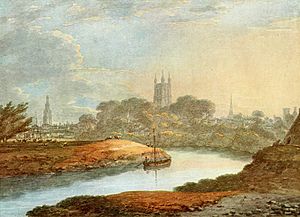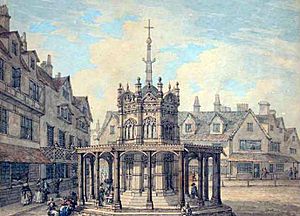Thomas Hearne (artist) facts for kids



Thomas Hearne (born September 22, 1744 – died April 13, 1817) was an English artist. He was known for painting landscapes, making engravings, and illustrating books. Hearne's special way of painting with watercolours involved using soft, calm colors over a clear outline. He often used a fine brush, pen, or pencil for these outlines. Younger artists like Thomas Girtin and J. M. W. Turner studied his techniques.
Contents
Early Life and Art Training
Thomas Hearne was born in a place called Marshfield, Gloucestershire. When he was only five years old, his father passed away. Thomas then moved with his mother to Brinkworth, Wiltshire. Some people think that the nearby Malmesbury Abbey inspired his later interest in old Gothic buildings.
As a teenager, Thomas became an apprentice to his uncle. His uncle was a pastry cook in London. Right next door was a print shop. The owner, an engraver named Miller, likely helped Thomas get into the art world.
Winning Art Awards
The Royal Society of Arts used to give out prizes for people who completed challenges. In 1763, Thomas Hearne won an award for a still life painting. The next year, he won another prize for a painting of a horse.
By 1765, he started working as an apprentice for William Woollett. Woollett was a famous engraver. Woollett thought Thomas was the best landscape engraver of his time. Thomas stayed with him for six years, learning a lot.
In 1771, Thomas spent some time with Woollett and a young artist named George Beaumont. This trip inspired Beaumont to become a landscape painter too. Beaumont later traveled with Hearne to northern England and Scotland.
Hearne's Art Career
Before cameras were invented, artists often traveled with important people. They would draw the places they visited. In 1771, Hearne traveled to the Leeward Islands. This was because the new Governor-General, Sir Ralph Payne, asked him to draw 20 large landscapes. Ten of these were of Antigua.
Hearne stayed there for three and a half years. He drew the unique features of the islands. After returning to London, he spent two more years painting watercolours from these sketches. You can see his portrait of Sir Ralph Payne at the Victoria and Albert Museum in London.
Illustrating British History
In 1777, Hearne started a big project with an engraver named William Byrne. They worked on a book called The Antiquities of Great Britain. This book aimed to record and illustrate historic places across the country.
First, Hearne made drawings specifically for the project. Then, Byrne created engravings from these drawings. The pictures were about 10 by 7 inches in size. Descriptions were added in both French and English.
The artworks were sold in parts starting in 1778. In 1786, the first 52 pictures were put together into a book. A second book with 32 more pictures came out in 1807.
During his travels for this project, Hearne carefully studied nature. He added effects of light and atmosphere to his drawings. This was something not many artists had done before. He helped bring attention back to Gothic architecture. He also became one of the key artists in the English watercolour style.
Byrne also used Hearne's designs for another project. This was for a book called Rural Sports, starting in 1780.
Influence on Other Artists
Richard Payne Knight, who loved the 'picturesque' style of art, asked Hearne to draw his home. Hearne made several drawings of the grounds of Downton Castle in Herefordshire.
Hearne's art had a big impact on other famous artists. These included Thomas Girtin and J. M. W. Turner. Both of them copied Hearne's drawings to learn from him. They did this at the homes of Dr Thomas Monro and John Henderson Snr. These men were well-known art supporters at the time.
From 1781 to 1802, Hearne showed his landscape drawings and old building pictures at the Royal Academy in London. He was also a member of the Society of Antiquaries.
Portraits of Hearne
As a well-known artist in London, Hearne was sketched by George Dance. Dance's detailed pencil portraits were later made into etchings by William Daniell. These were published in a collection of portraits starting in 1804. The picture of Hearne was published in December 1809.
In 1812, Henry Monro painted Hearne using pastels. The National Portrait Gallery bought this portrait in 1912.
Later Recognition and Legacy
Thomas Hearne passed away in London on April 13, 1817. He was buried in Bushey, Hertfordshire.
Exhibitions and Collections
At an exhibition in Manchester in 1857, some of Hearne's works were shown. These included Old Ruin and Trees, Glasgow, and Holy Island Cathedral. In 1891, Hearne's art was part of the Royal Academy's yearly winter collection. This collection featured works by "Old Masters and Deceased Masters of the English School."
In the 1900s, an art historian named Adolph Oppé became interested in British watercolours from the 18th and early 19th centuries. This area had not been studied much before. In 1996, the Tate Gallery bought over 3,000 artworks from the Oppé collection. This included several works by Hearne, such as Linlithgow Castle and The Moat in Kent.
Art Market Value
In February 1966, Hearne's painting The Tower of London sold for 320 guineas. By 1994, a large panoramic painting by Hearne from the Leeward Islands could sell for £10,000. In June 2006, Hearne's Rowing on the River Wear Before Lumley Castle was sold at Sotheby's for £19,200.
Today, Thomas Hearne's paintings are owned by many museums and art galleries around the world. These include Tate Britain, the British Museum, the Indianapolis Museum of Art, the Museum of New Zealand, the Yale Center for British Art, and the Victoria and Albert Museum.




